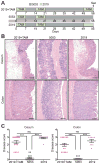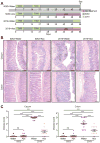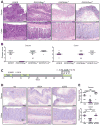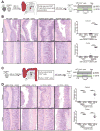Diet Modifies Colonic Microbiota and CD4+ T-Cell Repertoire to Induce Flares of Colitis in Mice With Myeloid-Cell Expression of Interleukin 23
- PMID: 29909020
- PMCID: PMC6174107
- DOI: 10.1053/j.gastro.2018.06.034
Diet Modifies Colonic Microbiota and CD4+ T-Cell Repertoire to Induce Flares of Colitis in Mice With Myeloid-Cell Expression of Interleukin 23
Abstract
Background & aims: Several studies have shown that signaling via the interleukin 23 (IL23) receptor is required for development of colitis. We studied the roles of IL23, dietary factors, alterations to the microbiota, and T cells in the development and progression of colitis in mice.
Methods: All mice were maintained on laboratory diet 5053, unless otherwise noted. We generated mice that express IL23 in CX3CR1-positive myeloid cells (R23FR mice) upon cyclic administration of tamoxifen dissolved in diet 2019. Diets 2019 and 5053 have minor differences in the overall composition of protein, fat, fiber, minerals, and vitamins. CX3CR1CreER mice (FR mice) were used as controls. Some mice were given antibiotics, and others were raised in a germ-free environment. Intestinal tissues were collected and analyzed by histology and flow cytometry. Feces were collected and analyzed by 16S rDNA sequencing. Feces from C57/Bl6, R23FR, or FR mice were fed to FR and R23FR germ-free mice in microbiota transplant experiments. We also performed studies with R23FR/Rag-/-, R23FR/Mu-/-, and R23FR/Tcrd-/- mice. R23FR mice were given injections of antibodies against CD4 or CD8 to deplete T cells. Mesenteric lymph nodes and large intestine CD4+ cells from R23FR or FR mice in remission from colitis were transferred into Rag-/- mice. CD4+ cells were isolated from donor R23FR mice and recipient Rag-/- mice, and T-cell receptor sequences were determined.
Results: Expression of IL23 led to development of a relapsing-remitting colitis that was dependent on the microbiota and CD4+ T cells. The relapses were caused by switching from the conventional diet used in our facility (diet 5053) to the diet 2019 and were not dependent on tamoxifen after the first cycle. The switch in the diet modified the microbiota but did not alter levels of IL23 in intestinal tissues compared with mice that remained on the conventional diet. Mesenteric lymph nodes and large intestine CD4+ cells from R23FR mice in remission, but not from FR mice, induced colitis after transfer into Rag-/- mice, but only when these mice were placed on the diet 2019. The CD4+ T-cell receptor repertoire of Rag-/- mice with colitis (fed the 2019 diet) was less diverse than that from donor mice and Rag-/- mice without colitis (fed the 5053 diet) because of expansion of dominant T-cell clones.
Conclusions: We developed mice that express IL23 in CX3CR1-positive myeloid cells (R23FR mice) and found that they are more susceptible to diet-induced colitis than mice that do not express IL23. The R23FR mice have a population of CD4+ T cells that becomes activated in response to dietary changes and alterations to the intestinal microbiota. The results indicate that alterations in the diet, intestinal microbiota, and IL23 signaling can contribute to pathogenesis of inflammatory bowel disease.
Keywords: Cytokine; Immune Response; Inflammatory Bowel Disease Model; Microbiome.
Copyright © 2018 AGA Institute. Published by Elsevier Inc. All rights reserved.
Conflict of interest statement
Both R.S. and A.J. are co-founders of Girihlet Inc., which has licensed the TCR sequencing technology from Mount Sinai, with the goal of developing it as a commercial product. JF.C. has served as consultant, advisory board member or speaker for AbbVie, Amgen, Boehringer-Ingelheim, Celgene Corporation, Celltrion, Enterome, Ferring, Genentech, Janssen and Janssen, Lilly, Medimmune, Merck & Co., Pfizer, PPM Services, Protagonist, Second Genome, Seres, Shire, Takeda, Theradiag, Theravance Biopharma. Stock options: Intestinal Biotech Development, Genfit. JF.C. has research Grants from AbbVie, Takeda, Janssen. The remaining authors disclose no conflicts.
Figures







Similar articles
-
Interactions Between Diet and the Intestinal Microbiota Alter Intestinal Permeability and Colitis Severity in Mice.Gastroenterology. 2018 Mar;154(4):1037-1046.e2. doi: 10.1053/j.gastro.2017.11.030. Epub 2017 Nov 23. Gastroenterology. 2018. PMID: 29174952 Free PMC article.
-
Enteric Delivery of Regenerating Family Member 3 alpha Alters the Intestinal Microbiota and Controls Inflammation in Mice With Colitis.Gastroenterology. 2018 Mar;154(4):1009-1023.e14. doi: 10.1053/j.gastro.2017.11.003. Epub 2017 Nov 11. Gastroenterology. 2018. PMID: 29133078
-
GPR120 Inhibits Colitis Through Regulation of CD4+ T Cell Interleukin 10 Production.Gastroenterology. 2022 Jan;162(1):150-165. doi: 10.1053/j.gastro.2021.09.018. Epub 2021 Sep 16. Gastroenterology. 2022. PMID: 34536451 Free PMC article.
-
The IL23-IL17 Immune Axis in the Treatment of Ulcerative Colitis: Successes, Defeats, and Ongoing Challenges.Front Immunol. 2021 May 17;12:611256. doi: 10.3389/fimmu.2021.611256. eCollection 2021. Front Immunol. 2021. PMID: 34079536 Free PMC article. Review.
-
T cell transfer model of chronic colitis: concepts, considerations, and tricks of the trade.Am J Physiol Gastrointest Liver Physiol. 2009 Feb;296(2):G135-46. doi: 10.1152/ajpgi.90462.2008. Epub 2008 Nov 25. Am J Physiol Gastrointest Liver Physiol. 2009. PMID: 19033538 Free PMC article. Review.
Cited by
-
The disruption of intestinal homeostasis when foods are colored red.Cell Mol Immunol. 2022 Jul;19(7):855-857. doi: 10.1038/s41423-022-00875-0. Epub 2022 Jun 11. Cell Mol Immunol. 2022. PMID: 35690680 Free PMC article. No abstract available.
-
Gut T cell-independent IgA responses to commensal bacteria require engagement of the TACI receptor on B cells.Sci Immunol. 2020 Jul 31;5(49):eaat7117. doi: 10.1126/sciimmunol.aat7117. Sci Immunol. 2020. PMID: 32737068 Free PMC article.
-
Interleukin 22 disrupts pancreatic function in newborn mice expressing IL-23.Nat Commun. 2019 Oct 4;10(1):4517. doi: 10.1038/s41467-019-12540-8. Nat Commun. 2019. PMID: 31586069 Free PMC article.
-
Macrophage interactions with fungi and bacteria in inflammatory bowel disease.Curr Opin Gastroenterol. 2018 Nov;34(6):392-397. doi: 10.1097/MOG.0000000000000479. Curr Opin Gastroenterol. 2018. PMID: 30239343 Free PMC article. Review.
-
Microbiota as key factors in inflammatory bowel disease.Front Microbiol. 2023 Oct 13;14:1155388. doi: 10.3389/fmicb.2023.1155388. eCollection 2023. Front Microbiol. 2023. PMID: 37901813 Free PMC article. Review.
References
-
- Ng SC, Shi HY, Hamidi N, et al. Worldwide incidence and prevalence of inflammatory bowel disease in the 21st century: a systematic review of population-based studies. Lancet. 2017;390:2769–2778. - PubMed
-
- Kamada N, Seo SU, Chen GY, et al. Role of the gut microbiota in immunity and inflammatory disease. Nature Reviews Immunology. 2013;13:321–335. - PubMed
-
- Nishikawa J, Kudo T, Sakata S, et al. Diversity of mucosa-associated microbiota in active and inactive ulcerative colitis. Scandinavian Journal of Gastroenterology. 2009;44:180–186. - PubMed
Publication types
MeSH terms
Substances
Grants and funding
LinkOut - more resources
Full Text Sources
Other Literature Sources
Molecular Biology Databases
Research Materials

